Creating a secure and sustainable living space is paramount in the ever-evolving world of prepping and survival. Building a survival cabin is one of the most practical and rewarding projects a survivalist can undertake. Whether preparing for unpredictable natural disasters, planning a remote getaway, or simply aiming to live off-grid, a survival cabin offers a sanctuary that blends self-sufficiency with comfort.
Key Takeaways
- A survival cabin is a basic, often small shelter that serves as a retreat during emergencies like natural disasters or for recreational uses such as hunting or escaping daily stress.
- Choosing the right location for a survival cabin involves considering several critical factors, such as accessibility, water supply, food sources, isolation, and safety.
- The construction process of a survival cabin includes selecting and preparing logs, laying a foundation, erecting walls, and installing roofing.
- Proper insulation is vital for maintaining a comfortable indoor temperature year-round, keeping the cabin warm in the winter and cool in the summer.
- Integrating sustainable features into the cabin’s design, such as solar panels, rainwater collection systems, and energy-efficient materials, reduces the environmental impact and boosts the cabin’s functionality in off-grid living conditions.
This article will guide you through the essential steps to design and construct a robust survival cabin tailored to withstand the elements and provide peace of mind. From selecting the ideal location to choosing the right materials and implementing sustainable practices, it’ll equip you with the knowledge you need to start your journey toward building a dependable survival retreat.
What is a Survival Cabin?
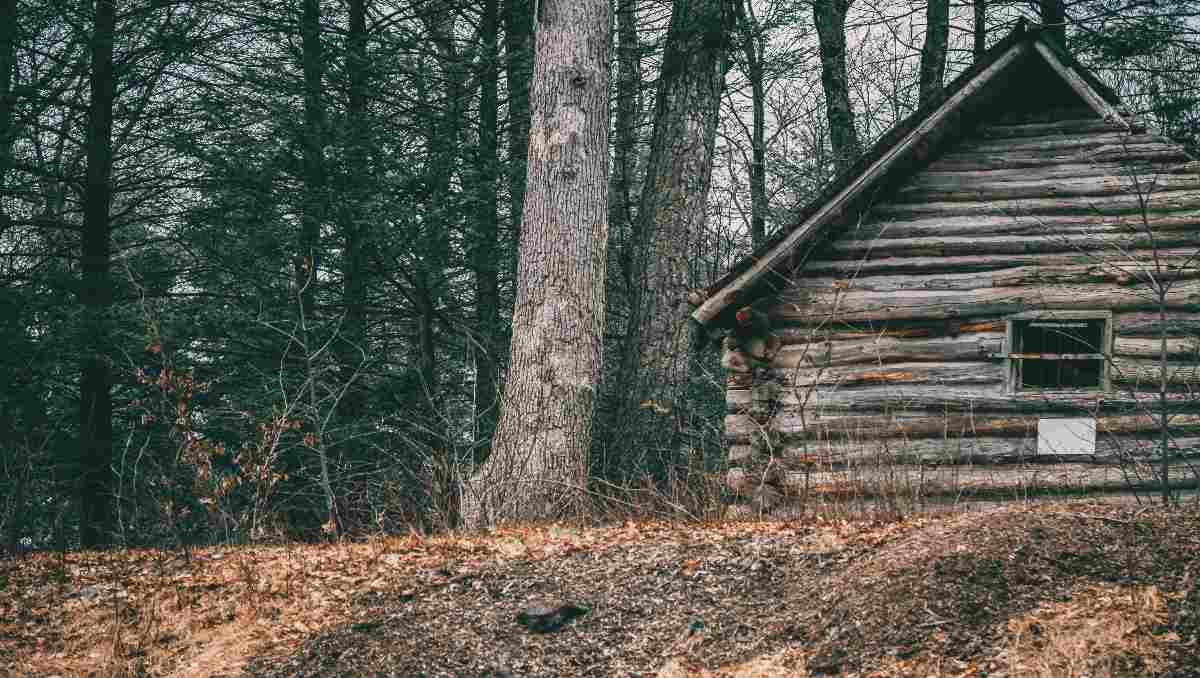
A survival cabin is essentially a basic, often small shelter that can serve as a retreat in times of necessity, such as emergencies, or for recreational purposes like hunting or simply getting away from everyday stresses. Furthermore, survival cabins are typically built with materials available on the land and designed to be off-grid, providing a place to sleep, eat, and stay warm and clean.
In detail, the construction of a survival cabin can vary depending on the available resources and the builder’s skills. Most commonly, it involves using logs, which are selected based on size and suitability from the surrounding environment.
Overall, these cabins are often used as a practical solution for temporary survival shelter in the wilderness, offering protection and basic amenities with minimal environmental impact. Ultimately, the simplicity of the design and the use of natural materials make these cabins popular among those preparing for survival situations or seeking a rustic, back-to-nature lifestyle.
Why Do You Need a Survival Cabin?
Building a survival cabin is an investment in your safety and well-being. Here’s why having one can make a significant difference:
Emergency Shelter
Imagine facing a severe storm or societal upheaval. Your survival cabin becomes a reliable refuge, a place built to withstand harsh conditions and keep you safe. Its robust construction and self-sufficient design mean you have a sanctuary that protects you from both natural elements and potential threats.
Self-Sufficiency
Picture yourself living off the grid, free from the dependency on external utilities. With features like a well or rainwater harvesting system and solar panels for energy, your cabin empowers you to sustain yourself. It’s a step toward independence, knowing you can manage your power and water needs without relying on public services.
Mental Health Retreat
Life can be overwhelming, and we all need a break. Fortunately, a survival cabin offers a peaceful escape, nestled in nature’s beauty. Moreover, it is a place where you can disconnect from the daily grind and reconnect with yourself, finding tranquility and rejuvenation in the simplicity of your surroundings.
Wildlife Protection
Your cabin provides a secure spot to retreat to, keeping you safe from wildlife encounters. Its sturdy construction and secure food storage help ensure that curious animals don’t become a threat, allowing you to enjoy the wild without worry.
Customization for Needs
Everyone’s needs are different, and your survival cabin can reflect that. Whether you’re planning for short-term getaways or preparing for long-term habitation, you can design and outfit your cabin to match your specific preferences. From the layout to the amenities, it’s a space tailored just for you.
Community and Security
Being part of a like-minded community can be invaluable during a crisis. Alternatively, if you prefer solitude, a secluded survival cabin can offer privacy and reduce unwanted attention. Either way, your cabin can provide the security and sense of belonging that suits your needs.
Planning and Preparation
Building a survival cabin is not just about assembling materials and following construction steps; it requires thoughtful planning and thorough preparation to ensure the cabin meets all necessary requirements for safety, sustainability, and comfort.
Choosing the Right Location
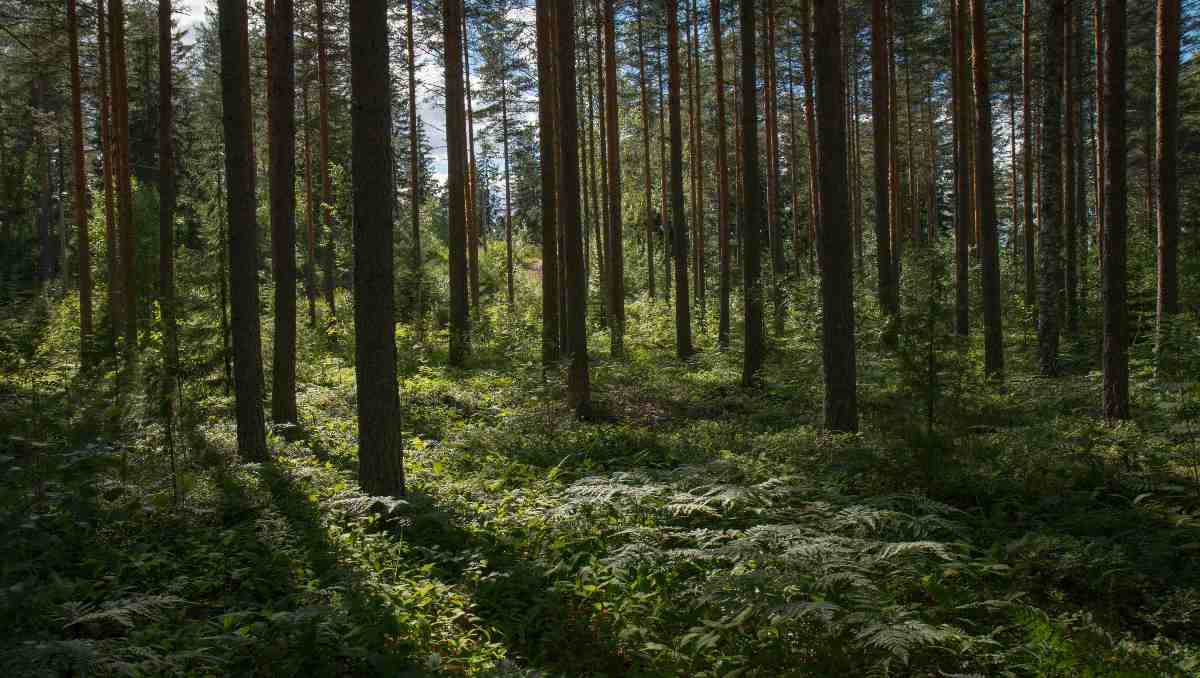
Choosing the right location for your survival cabin is crucial. Accessibility is vital, so ensure it is within a tank of gas from your primary residence and reachable via multiple routes for emergencies.
A reliable water supply is essential, whether from a natural spring, river, or a well you can install, to ensure clean water for drinking, cooking, and hygiene. Consider food sources as well, such as fertile land for growing your own food or areas rich in wildlife and native plants.
Additionally, conduct soil tests to understand the soil type, pH level, and drainage capacity to guide decisions about the cabin’s foundation and the suitability of the land for growing food. Assess wind patterns and solar exposure to optimize natural ventilation, position wind turbines effectively, and maximize natural light and heat for energy efficiency and reduced heating costs.
While accessibility is important, the location should also offer some isolation to avoid overcrowding during crises and provide privacy and security. Evaluate the area’s safety by considering its visibility, ease of defense, and natural barriers against intruders.
Consider natural threats like floods, wildfires, or seismic activity to choose a location that minimizes exposure to these hazards. Ensure the local climate supports year-round living, taking into account extreme weather, the growing season for crops, and overall comfort. Lastly, be aware of local regulations, including zoning laws, environmental protections, and building codes, which could impact your plans.
Designing Your Survival Cabin
Designing your survival cabin with efficiency and sustainability in mind can make a significant difference. A compact design is often more energy-efficient, requiring less material to build and less energy to heat and cool, thus reducing both environmental footprint and construction costs.
The cabin’s orientation is crucial; positioning it to maximize natural light and solar gain can make a huge difference. For instance, large, south-facing windows can warm the cabin in winter, while in hot climates, shading these windows helps keep the cabin cool.
Also, thoughtful land use minimizes disruption to the natural landscape. Consider the impact on local flora and fauna and use landscaping that complements the local ecosystem. Designing a survival cabin with these principles ensures it is not only functional and comfortable but also sustainable and in harmony with nature.
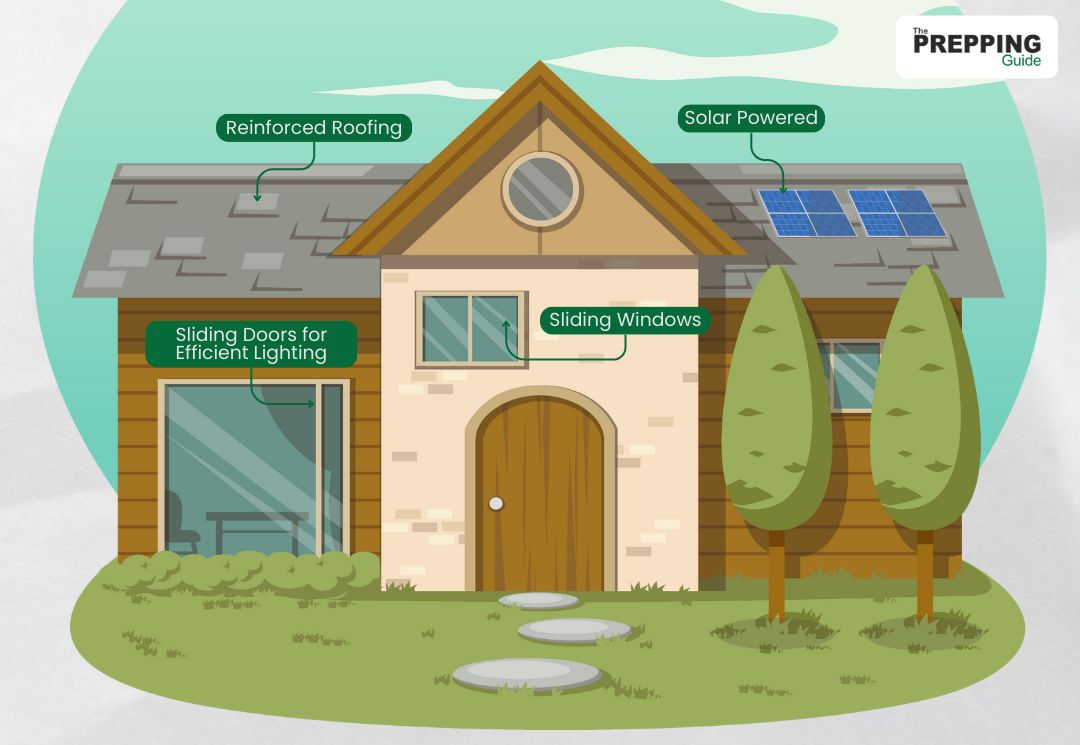
Picking the Right Building Materials
Choosing the right building materials is crucial for durability, safety, and environmental sustainability. Here’s a detailed look at various materials that are commonly used in cabin construction, emphasizing sustainable and durable options:
Wood
Wood is the most traditional building material for cabins and is prized for its natural insulation properties, ease of use, and renewable nature. When using wood, opt for locally sourced timber to reduce transportation emissions, and consider using reclaimed or recycled wood to minimize environmental impact. Woods like cedar and redwood are popular due to their natural resistance to rot and pests.
Stone
Stone is another sustainable building material that offers excellent durability and thermal mass, helping to regulate the cabin’s internal temperature. Using stone sourced from local quarries can reduce the environmental impact associated with transportation. Stone is ideal for foundations, walls, and fireplaces.
Straw Bales
Straw bale construction is a sustainable option that provides exceptional insulation. Straw is a by-product of grain production; using it in building can help reduce waste. Straw bale walls are also known for their fire resistance when properly plastered.
Bamboo
Bamboo is a fast-growing, sustainable material that is gaining popularity in construction due to its strength, flexibility, and environmental friendliness. It is especially suitable for structural elements, flooring, and paneling.

Earth
Using earth in forms such as rammed earth or cob is a traditional technique with minimal environmental impact. These materials are excellent for thermal mass, keeping the cabin cool in summer and warm in winter.
Recycled Steel
Steel is a durable material that can be recycled without degradation in quality. Using recycled steel for frames and roofs can help reduce the carbon footprint of your cabin construction.
If you’re unsure which materials you should pick, here’s a comparison table you can use as a guide:
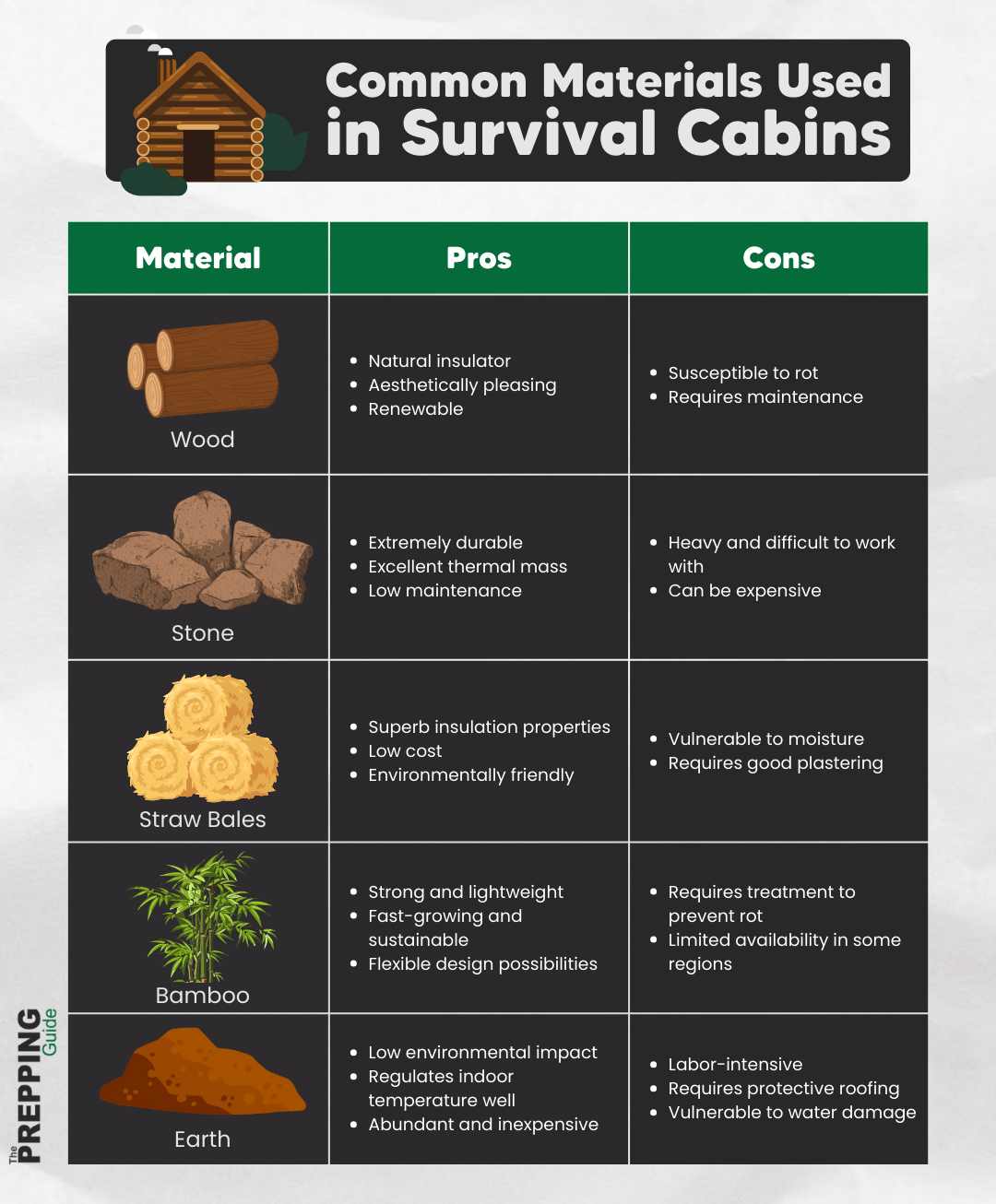
Water Source and Purification
Having access to a reliable water source is perhaps one of the most critical components of your survival cabin. Identify nearby natural water sources, such as streams or lakes, and plan for rainwater collection systems as a supplementary source.
For purification, consider multiple methods such as boiling, chemical tablets, or a solar distillation system. This redundancy ensures you always have access to safe drinking water, regardless of the circumstances.
Powering Your Cabin
Living off-grid requires a reliable power solution tailored to your geographic and environmental conditions. Solar power systems are popular for their versatility and decreasing cost but don’t overlook the potential of wind or hydro power if your location supports it.
Energy storage, like batteries, is also essential to maintain power supply during periods without sufficient sunlight or wind. Plan your energy usage carefully to ensure your power system meets your needs year-round.
Heating and Insulation Techniques
Effective heating and insulation are vital for comfort and survival in harsh climates. Wood stoves are a popular choice for heating because they can use the same renewable resource that might surround your cabin—trees. Modern insulation materials such as spray foam provide excellent thermal resistance and help seal any air leaks.
Additionally, consider passive solar heating by positioning your cabin to take advantage of the sun’s heat during colder months and design overhangs to shade windows in the summer. This natural method can significantly reduce your energy consumption for heating and cooling.
Security Measures
When it comes to securing a survival cabin, implementing solid security measures is crucial to ensure safety and protect resources. Here are some essential security measures to consider:
Sturdy Construction
Use durable materials for construction to resist forced entry and withstand harsh weather conditions. Reinforced doors, windows, and locks can significantly enhance security.
Location and Visibility
Choose a location that offers natural concealment while maintaining a clear line of sight around the cabin’s perimeter. Avoid being too visible to passersby, making the cabin a target. Strategic placement of the cabin can leverage natural barriers like water bodies or rocky terrains for added protection.
Defensive Perimeter
Establish a secure perimeter around the cabin. This might include fences, gates, or natural barriers that can deter unauthorized entry. Thorny plants or bushes under windows can also be an effective and natural deterrent.
Surveillance
Consider installing a surveillance system, including cameras and motion sensors, which can alert you to any movement around the property, and ensure that these systems can be monitored remotely if necessary.
Lighting
Adequate exterior lighting can deter intruders. Solar-powered lights with motion sensors are a sustainable option that can be effective in keeping the area around the cabin well-lit during the night.
Secure Storage
Have secure storage for valuable items and resources like survival food, water, and tools. Safes or reinforced storage rooms can protect these essentials from theft and environmental factors.
Communication Systems
Maintain reliable communication systems to call for help if needed. This could include satellite phones, radios, or cellular devices, depending on the location and availability of services.
Emergency Plan
Develop a comprehensive emergency response plan that includes evacuation routes, rendezvous points, and procedures for different types of threats. Additionally, regularly review and practice this plan with all cabin users.
Community Networking
If in a community of cabins or near other residents, networking can enhance security. Establishing a good relationship with neighbors can lead to mutual assistance in need.
Building Your Survival Cabin: The Steps
Building your survival cabin involves clear steps, each critical to the integrity and functionality of the finished home. Here’s a step-by-step guide:
Step 1: Log Selection and Preparation
Selecting the right logs is the foundation of your cabin’s longevity and sturdiness. Be sure to look for mature, straight trees—typically softwoods like pine or fir—that are less prone to rot and easier to work with. Each log should be debarked and treated to prevent moisture retention and decay, ensuring your cabin stands strong for years.
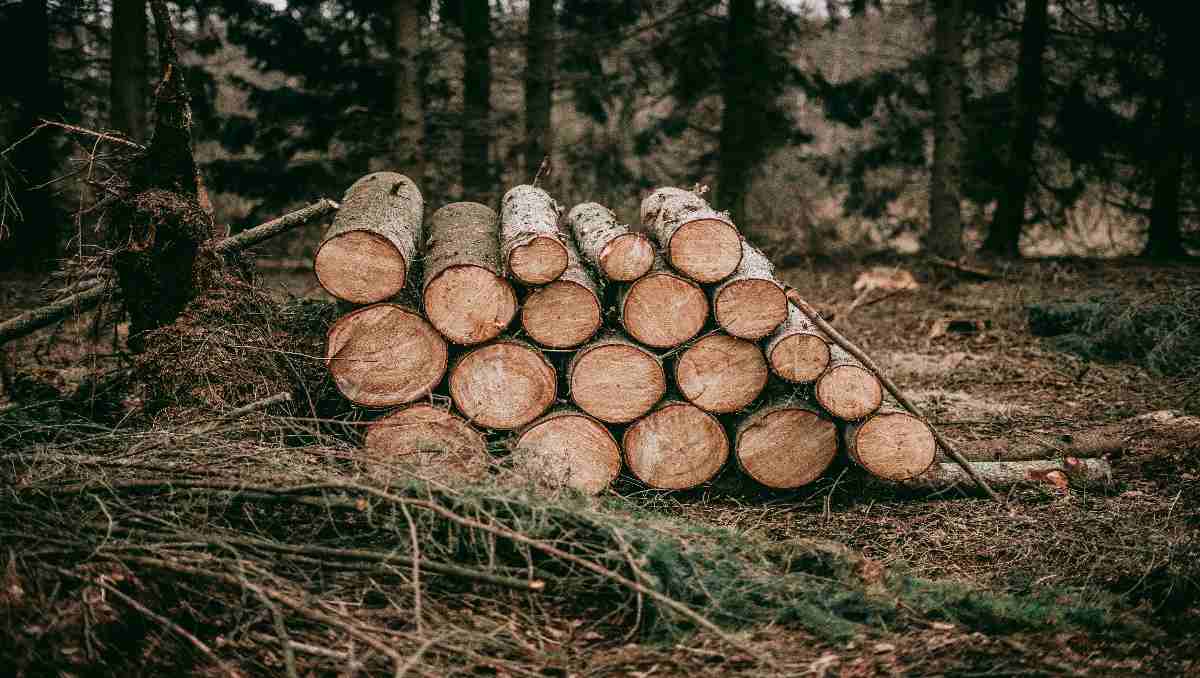
Here are the steps for log selection and preparation:
Select Resistant Wood: Choose wood types like cedar, redwood, or cypress for their natural resistance to decay.
Debark and Dry: Remove the bark to prevent insect infestation and moisture trapping. Allow logs to dry thoroughly to reduce moisture content.
Apply Preservatives: Treat the wood with borate for protection against insects and fungi or use oil-based preservatives like copper naphthenate for added waterproofing and UV protection.
Seal the Logs: Finish by sealing the logs with a water-repellent sealer to further protect against moisture.
Additionally, the preparation of your logs involves proper cutting and shaping. You’ll want to ensure that each log fits snugly with the next, creating tight seals that improve insulation and structural integrity. Techniques like notching can be learned through various resources or consulting experienced builders.
Step 2: Laying the Foundation
Start by clearing and leveling your chosen site, then decide on the foundation that best suits the terrain and your cabin design. A raised foundation can protect against moisture and pests, while a concrete pad might offer more stability and durability.
Moreover, the choice of foundation largely depends on the soil composition and topography of your chosen site. Here are detailed steps for three common types of foundations:
Gravel Bed Foundation:
- Clear and level the site, removing any vegetation and topsoil to reach the more stable subsoil.
- Lay a geotextile fabric to prevent weed growth and to stabilize the gravel over time.
- Spread a layer of gravel at least 6 inches thick. Use a compactor to compact the gravel evenly.
- Ensure the gravel surface is level and firm before constructing your cabin. Diagrams can show the correct layering and compaction techniques.
Concrete Piers:
- Determine the number of piers needed based on the cabin’s dimensions and mark their locations.
- Dig holes for the piers, deep enough to pass below the frost line to prevent shifting during freeze-thaw cycles.
- Set tube forms into the holes and pour concrete, ensuring they are vertical and level.
- Insert anchor bolts into the top of the wet concrete, which will be used to secure the cabin’s base frame.
Continuous Concrete Footer:
- First, excavate a trench around the perimeter of your cabin site, deep enough to go below the frost line.
- Next, build a formwork of wood around the perimeter, ensuring it is level and sturdy.
- Then, mix and pour concrete into the formwork, spreading it evenly and poking it to remove air pockets.
- Smooth the top of the footer with a trowel and ensure it is level. Allow the concrete to cure for at least one week before beginning construction on it.
Step 3: Erecting Walls
Different log notching techniques can dramatically affect the aesthetic and structural integrity of your cabin. Here are two common techniques:
Scandinavian Notch:
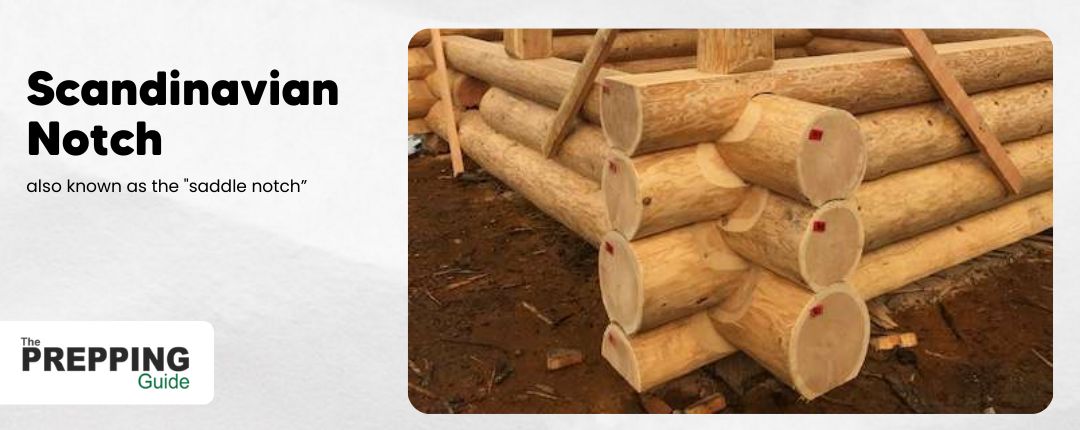
This notch, also known as the “saddle notch,” is designed to interlock the logs at the corners, creating a tight seal that improves insulation. Begin by cutting a semi-circular notch on the bottom of each log that will sit over another log, ensuring a snug fit that doesn’t compromise the structural integrity of the log.
Russian Notch:
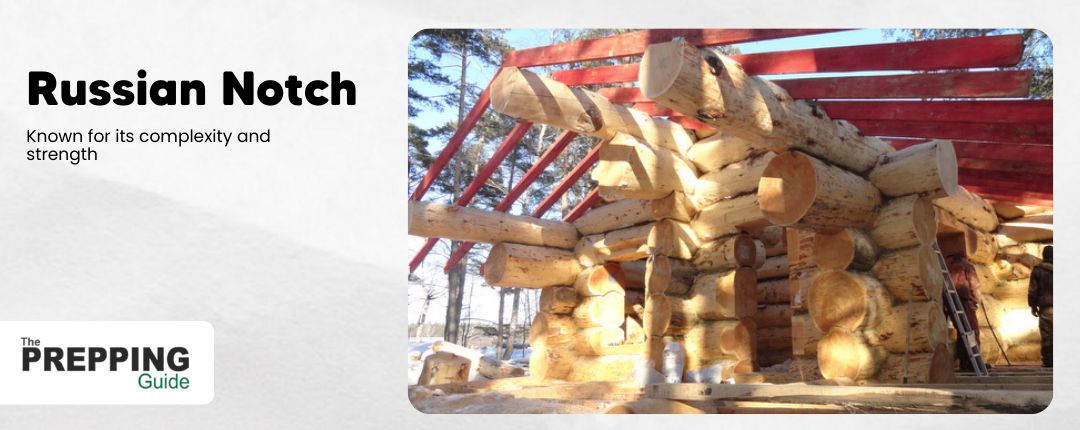
Known for its complexity and strength, the Russian notch involves creating an interlocking system that is nearly self-sustaining without the need for chinking. It requires precise cuts and is ideal for colder regions where excellent insulation is crucial.
As walls rise, remember to leave spaces planned for your doors and windows. Proper placement of these openings will aid in ventilation and light, making your cabin more comfortable and livable.
Step 4: Creating Openings (Doors and Windows)
Door and window openings are your cabin’s access points to the outside world and are crucial for light and air circulation. Be sure to frame these openings carefully to maintain the structural integrity of the walls. Use sturdy framing materials to support the cabin’s roof and upper structure.
Installation of doors and windows should be done precisely, ensuring they are square and secure. This step affects not only the look of your cabin but also its functionality in terms of security and insulation.
Step 5: Roofing
The roof is your cabin’s primary protection against the elements, so choosing the right materials and installation method is crucial. Traditional choices like wooden shingles or metal sheeting offer durability and ease of installation. Ensure the roof structure is robust, with sufficient overhang to protect the cabin walls from rain and snow.
Here are two common choices:
Gabled Roofs:
This classic roof style is characterized by two sloping sides that meet at a ridge, creating a triangle section on each end. Gabled roofs are relatively easy to construct and offer good water drainage.
Use heavy-duty roofing felt, followed by a waterproof membrane, and then cover with your chosen materials such as shingles or metal roofing. Ensure all seams and joints are sealed to prevent leaks.
Gambrel Roofs:
Gambrel roofs provide more headroom and space for a loft. They involve two different slopes on each side of the roof; the lower slope is steeper than the upper one.
Like with gabled roofs, start with a layer of heavy-duty felt, add a waterproof membrane, and finish with tiles or metal sheeting. Also, pay special attention to sealing the ridge and the change of slope to prevent water ingress.
Properly installing the roof involves securing it against wind and sealing it against water penetration. This step is vital to ensure your cabin remains dry and warm, no matter the weather conditions outside.
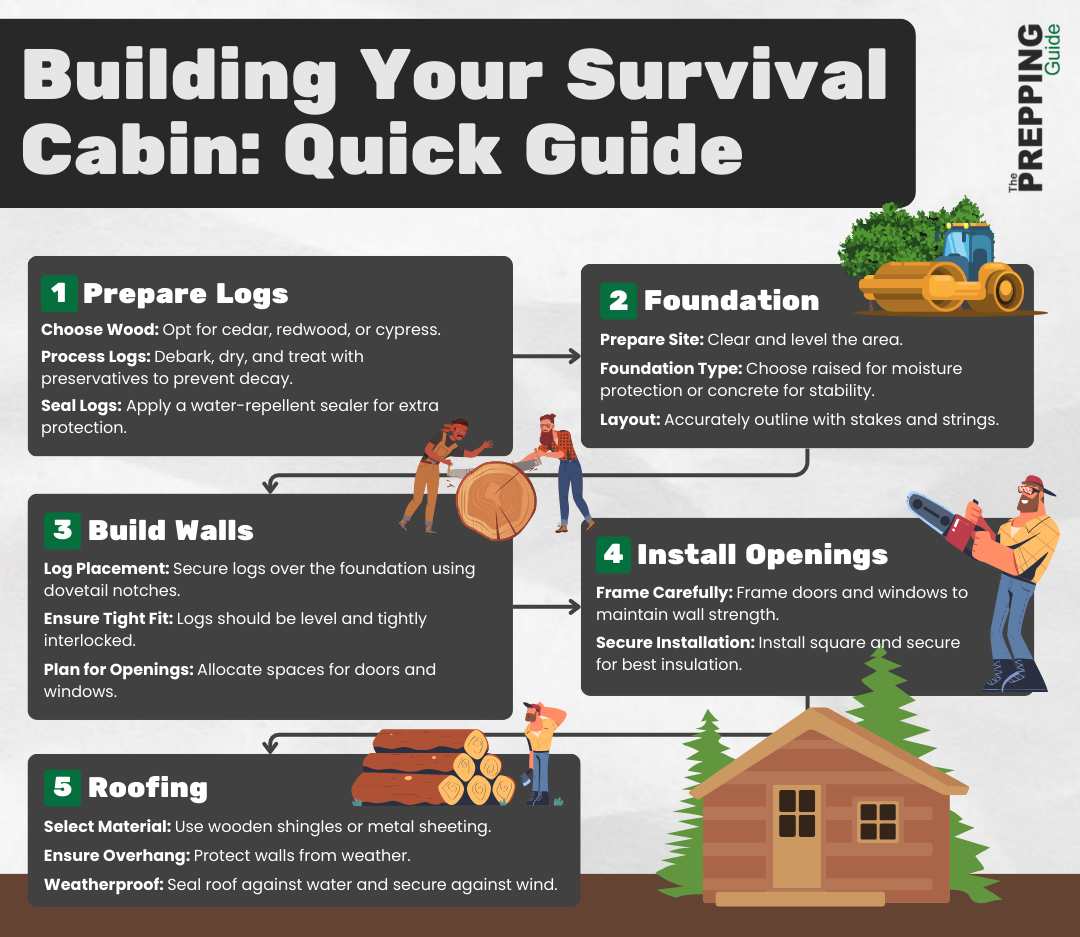
And if that’s not enough, here’s a video showing how to build a survival cabin:
Finishing Touches and Maintenance
With the structure complete, the next step is to make your cabin livable and maintain its condition over time.
Insulation and Weatherproofing
Effective insulation is key to keeping your cabin warm in the winter and cool in the summer. Materials such as spray foam or fiberglass batts can be used to fill gaps between logs and in the roof. This step is crucial for energy efficiency and comfort.
Research shows that “using energy-efficient materials for insulation significantly reduces heat loss or gain, which is crucial for maintaining thermal comfort and reducing energy costs.” Proper installation of these materials is essential to reap their full benefits.
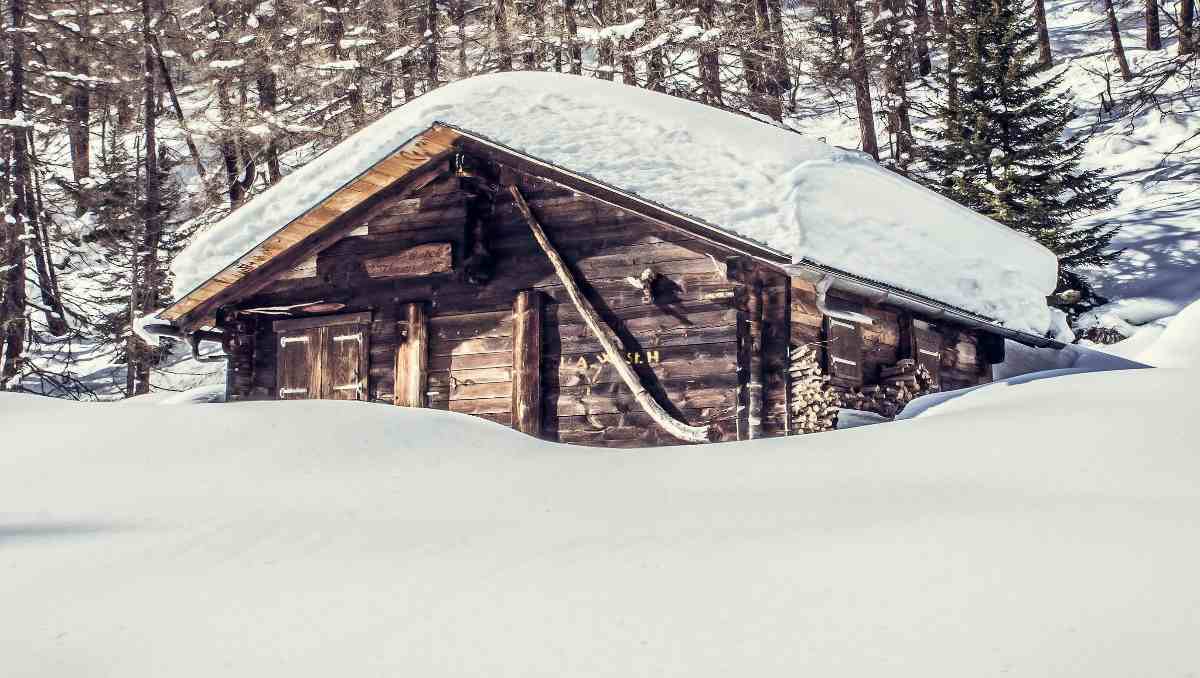
Weatherproofing involves sealing any potential entry points for moisture and air. Caulk around windows and doors, and apply weather stripping to ensure a tight seal. Additionally, regular checks and maintenance of these areas will help prolong the life of your cabin and maintain its comfort level.
Pest and Damage Prevention
Pests can be a serious threat to your survival cabin. Use treated wood resistant to insects, and consider a metal mesh or barriers in vulnerable areas like vents and where the ground meets the walls. Regular inspections for signs of infestation are crucial to prevent serious damage.
Additionally, preventative maintenance like checking for roof leaks, clearing debris from around the cabin, and inspecting for signs of wear and tear can save you from costly repairs in the future. Staying ahead of the maintenance curve ensures that your cabin remains a safe, secure, and comfortable place for years to come.
Sustainability Features
Incorporating sustainable features into your cabin reduces your environmental impact and enhances your self-sufficiency. Solar panels, rainwater harvesting systems, and composting toilets are excellent ways to make your cabin more eco-friendly while providing ongoing resources.
Plan for sustainability from the start, as retrofitting these features can be more difficult and expensive. These systems save on operational costs and ensure that your cabin has minimal impact on its surrounding environment.
Conclusion
Building a survival cabin is incredibly rewarding. It combines practical self-sufficiency with the tranquility of nature. Whether you’re protecting against disasters, seeking a peaceful retreat, or living off-grid, constructing a survival cabin gives you not just shelter but a durable, sustainable home. By choosing the right location, using strong materials, and adding eco-friendly technologies, you create a comfortable, secure, and peaceful environment.
The process demands careful planning, from the first blueprint to the finishing touches. Every step, from preparing the logs to installing the roof, guarantees your cabin’s durability and usability. Additionally, the option to customize your cabin ensures it suits your specific requirements, whether for emergency readiness, eco-friendly living, or a serene getaway from urban life.
FAQs
How long does it take to build a survival cabin?
The time it takes to build a survival cabin can vary significantly based on several factors such as the complexity of the design, the materials used, the builder’s experience, and the number of people involved in the construction. Generally, a basic survival cabin can take a few months to build if working intermittently.
How long can you live in a cabin?
The length of time you can live in a cabin depends on various factors such as location, construction quality, available resources, and lifestyle preferences. With proper planning and maintenance, some people choose to live in cabins indefinitely, enjoying a sustainable and self-sufficient lifestyle.
Is it cheaper to buy or build a cabin?
Whether buying or building a cabin is cheaper depends on factors like location, materials, labor costs, and personal preferences. Building a cabin from scratch allows for customization and potentially lower costs if you can do some of the work yourself, while buying a pre-built cabin may offer convenience but could be more expensive upfront.

Maybe I missed it but I didnt see any type of heat source built into these cabins.
How difficult would it be to build a fireplace in one of these cabins?
Would you build the cabin first or the fireplace first then build the cabin around it?
Did anyone reply to this!??
“If you have more time, and want to invest that time in building a more firm and homely survival cabin, you can, of course, use more tools.”
The word homely means ugly or unattractive. It has nothing to do with the cozy setting of a home.